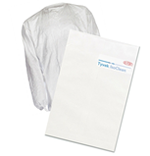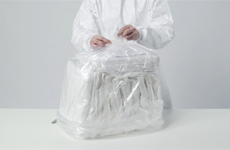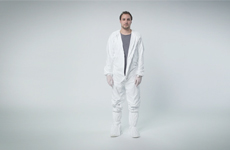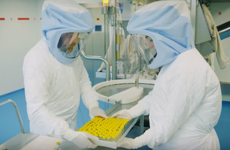 DuPont Tyvek® IsoClean® garments and accessories
DuPont Tyvek® IsoClean® garments and accessories
CONFIDENCE IN YOUR CLEANROOM
Tyvek® IsoClean® products help to reduce contamination incidents, ensure best quality of processes and products, at the same time providing reliable protection to wearers.
| For many years, DuPont ™Tyvek® has been putting science to work by creating protective clothing solutions essential to keep people, products and processes safe. With Tyvek® IsoClean® garments and accessories, DuPont has developed an innovative range, based on its technical know-how, which corresponds to the highest standards for particle and microbiological contamination control. |
 |
Try IsoClean® |
| Products |
Gowning for controlled environments
| Tyvek® IsoClean® Bouffant |
Tyvek® IsoClean® Hood |
|
| Tyvek® IsoClean® Hood and Mask |
DuPont™ Sierra™ Mask |
|
Tyvek® IsoClean® Gown |
Tyvek® IsoClean® Sleeves |
|
| Tyvek® IsoClean® Coverall |
||
Tyvek® IsoClean® Shoe Covers |
Tyvek® IsoClean® Boot Covers |
| Benefits |
Tyvek® IsoClean® double packaging
Why cleanroom packaging matters?
All Tyvek® IsoClean® clean-processed and sterile garments come in sealed cleanroom packaging consisting of an inner and outer packaging (double bag), with easy opening.
- This concept helps to manage contamination risks when transferring clothing into clean areas
- They are also packed in an ISO Class 4 certified cleanroom, to avoid the risk of cross-contamination
- Garment folding pattern enables aseptic gowning

Tyvek® IsoClean® coverall model IC183B DS design
What is the role of a cleanroom garment?
One of the biggest task of cleanroom clothing is protecting sensitive products and processes from human contamination, like microorganisms released through skin, hair, sweat or saliva. Apart from being a fabric barrier, design features can significantly reduce contamination risk.
- Design must be ergonomic and enable freedom of movement to operate comfortably
- Good fit e.g. correct size and elastics will prevent unnecessary movement and loose fabric
- Elasticated thumb loops prevent sleeves from riding up
- Storm flap in the front that covers the zip (which can be a potentially be contamination source)
- Bound internal seams reduce the risk of penetration of liquid and particles

Step into the cleanroom and learn more on Tyvek® IsoClean®
What is the role of a cleanroom garment?
One of the biggest task of cleanroom clothing is protecting sensitive products and processes from human contamination, like microorganisms released through skin, hair, sweat or saliva. Apart from being a fabric barrier, design features can significantly reduce contamination risk.
- Design must be ergonomic and enable freedom of movement to operate comfortably
- Good fit e.g. correct size and elastics will prevent unnecessary movement and loose fabric
- Elasticated thumb loops prevent sleeves from riding up
- Storm flap in the front that covers the zip (which can be a potentially be contamination source)
- Bound internal seams reduce the risk of penetration of liquid and particles
Tyvek® IsoClean® product portfolio

See the future of aseptic grade A/B manufacturing
Experience the excellent combination of ViVi-CR hood system and DuPont Tyvek® IsoClean® clothing for optimal personal and product protection.

Instructional gowning video
GMP compliant donning & doffing procedures of Tyvek® IsoClean® clothing and ViVi_CR hood system

| FAQ |
Tyvek® is a flash-spun high density polyethylene fabric only made by DuPont. Tyvek® fabric offers an inherent, breathable barrier that cannot easily be worn or abraded away. This inherent Tyvek® barrier is not dependent on a thin film or a thin layer of small fibres - with Tyvek®, every part of the fabric provides a barrier. This delivers an effective breathable barrier to particles created by this unique fabric structure.
Tyvek® IsoClean® (Option Code CS, DS and MS) garments are most typically considered for use in GMP A-D, ISO Class 5 to 8 (former Federal Standard 209E classes 100 to 100 000) cleanroom environments. However, use in ISO Class 4 and 9 environments may also be considered depending on the needs of a particular application. In all cases, garment choice depends garment design and processing, as well as the needs of specific applications. Clean-processed and bound-seam garments offer the highest level of contamination control and should be used in more critical applications. Sterile garments are available if required. It is the end-user’s responsibility to determine the appropriate garment for a given application.
Non sterile garments are available in:
Bulk (Option Code 0B or 00): Case quantities are packed in a cardboard case with two polyethylene liners
Sterile garments are available in:
Clean-processed and sterile (Option Code CS, DS and MS):
Garments are specially processed to minimise particle shedding, then folded to aid aseptic donning and individually packed in an ISO Class 4 cleanroom. The case quantity is packed in a cardboard case with two polyethylene liners. Sterility is achieved by gamma irradiation. Irradiation dosage is validated in accordance with ISO 11137 for a sterility assurance level (SAL) of 10–6. All DuPontTM Tyvek® IsoClean® clean-processed and sterile accessories (Option Code MS and DS) are packed in a dual-barrier validated packaging system, consisting of an inner and outer easy tear, validated, cleanroom bag. The system serves both as an additional sterility risk management component and is a key element for contamination risk reduction when transferring apparel into clean areas.
Sterile (Option code 0S): Garments are folded to aid aseptic donning and individually packed. The case quantity is packed in a cardboard case with two polyethylene liners. Some sterile items are folded and individually packed in an ISO Class 5 cleanroom. Sterility is achieved by gamma irradiation. Irradiation dosage is validated in accordance with ISO 11137 for a sterility assurance level (SAL) of 10–6.
Sterile items are generally considered to remain sterile if the package integrity has not been compromised (no breach of package or seals). Aging studies indicate that Tyvek® IsoClean® garments have a sterility expiration date of at least five years when stored in original packaging under proper storage conditions. For sterile Tyvek® IsoClean® products, the product expiration date is located on the bag and box label. DuPont suggests that non sterile Tyvek® IsoClean® garments be used within five years of receipt.
A certificate of sterility is provided with each case of sterile garments. Copies of certificates of sterility are available at www.safespec.dupont.co.uk.
Tyvek® IsoClean® garments that have been sterilised using gamma radiation will sometimes exhibit an odour, particularly when the packaging is first opened. This odour is expected and very normal. Are Tyvek® IsoClean® garments anti-static or static-dissipative? The fabric used to make Tyvek® IsoClean® garments is treated with a topical anti-static agent to help minimise static build-up and reduce nuisance garment cling. The topical antistat is water soluble, so anti-static performance is reduced in clean-processed garments. Sterilisation may also impact anti-static performance. In situations where static dissipation level is a critical performance property, end-users should evaluate the performance of their entire ensemble, as worn, including outer garments, inner garments, footwear and other personal protective equipment (PPE). For any garment system to be static-dissipative, it must be able to drain a charge build-up through proper grounding devices, such as, but not limited to, workstation grounding clips or static-dissipative floors. Check for CE-certified Tyvek® IsoClean® garments that meet EN 1149-5.
Coveralls may be stored between 15 and 25 °C in the dark (cardboard box) with no UV light exposure. DuPont suggests that Tyvek® IsoClean® coveralls be used within five years, provided they are properly stored and pass a full visual inspection. High temperature, oxidising gases, wet, cold, ultraviolet and ionising radiation can significantly impact the long-term life of coveralls made of Tyvek® fabric. For sterile products see expiry date on the bag label.
Currently DuPont offers the Tyvek® IsoClean® brand of cleanroom garments only in white.
Tyvek® fabric melts at 135 °C. Tyvek® and Tyvek® IsoClean® garments are not flame resistant or flame retardant. Garments should not be used around heat, flame or sparks.
Tyvek® IsoClean® brand garments offer limited splash protection, resist water penetration, are non absorbent and have equal strength wet or dry. Tyvek® IsoClean® garments are not recommended for protection from hazardous liquid chemicals; if protection from liquid hazardous chemicals is needed, consider DuPont™ Tychem® products available at www.safespec.dupont.co.uk.
Tyvek® coveralls can be incinerated or buried in a controlled landfill without harming the environment. Disposal of contaminated garments is regulated by national or local laws.
Yes, non contaminated garments used in cleanroom operations can be recycled for non hazardous applications.